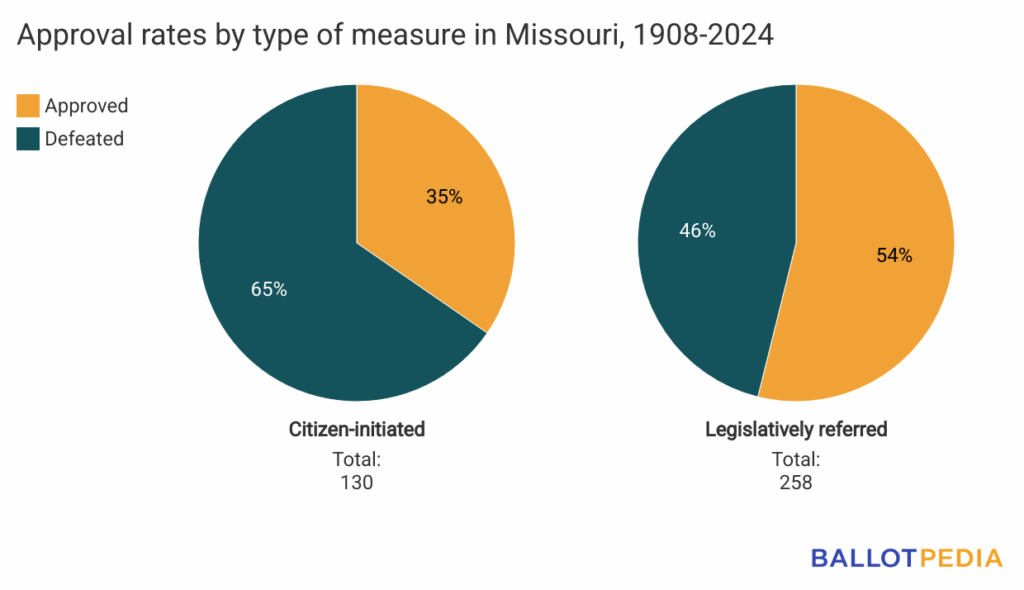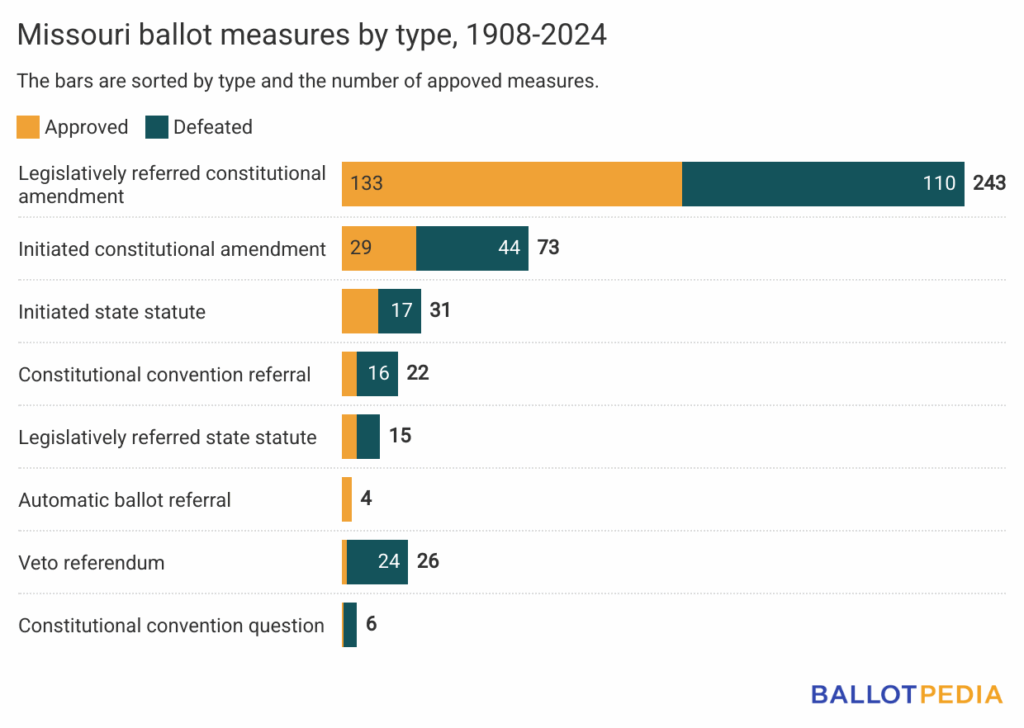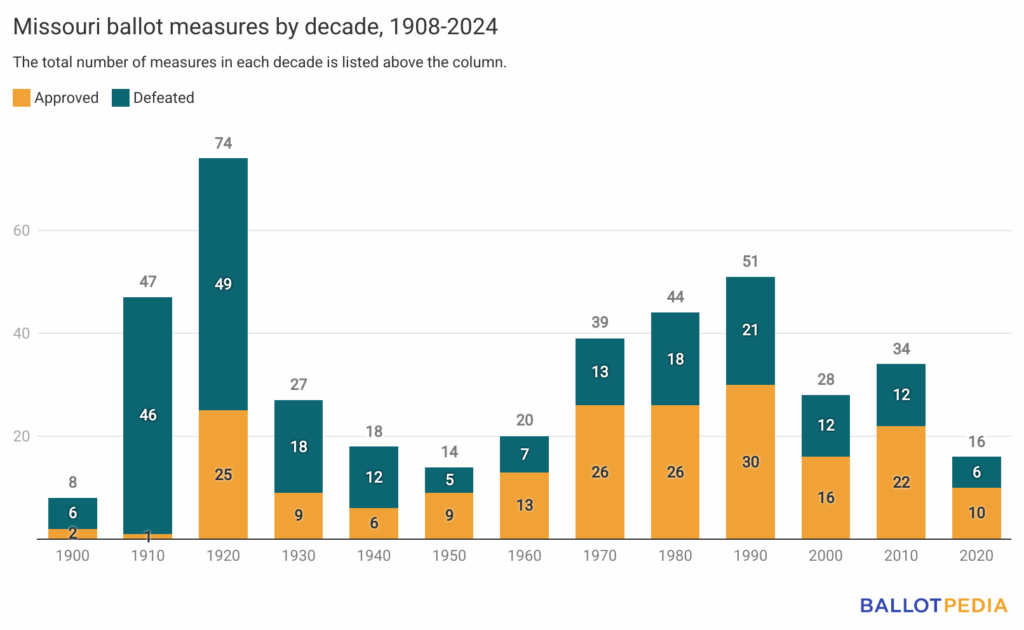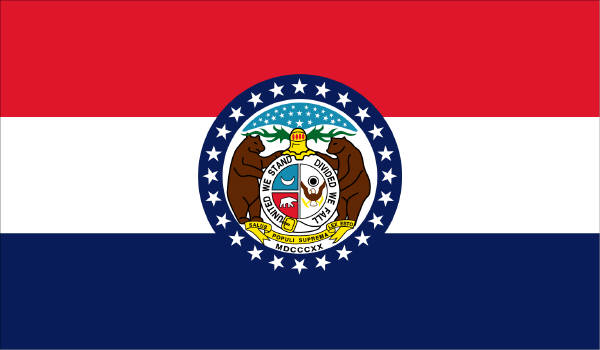Ballotpedia has completed an inventory of all Missouri ballot measures since 1908. Between 1908 and 2024, Missouri voters decided 420 ballot measures. Of these, 195 (46.4%) were approved, and 225 (53.6%) were defeated.
In Missouri, measures can be placed on the ballot through the state legislature, as well as through the citizen-initiated process. The citizen initiative process began in 1908 when voters approved Amendment 3, making Missouri the seventh state, along with Maine and Michigan, to provide for statewide citizen-initiated ballot measures.
Measures referred to the ballot by the Missouri State Legislature were approved more often than measures initiated by citizens. In total, 258 measures were referred to the ballot by the legislature, and 130 measures were placed on the ballot by a successful citizen initiative. Of the legislative referrals, 139 (54%) were approved and 119 were defeated, while out of the citizen initiatives, 45 (35%) were approved and 85 were defeated. The other 32 measures were automatic referrals or questions or constitutional convention referrals.

There are eight different types of ballot measures in Missouri. Legislatively referred constitutional amendments appeared on the ballot the highest number of times (243). Besides the types that had one measure (one automatic ballot referral and one constitutional convention referral were approved by voters), legislatively referred constitutional amendments also had the highest success rate at the ballot box, with 52% being approved by voters. Veto referendums had the lowest approval rate of any ballot measure type, with 92% rejected by voters. Because a 'no' vote on a veto referendum repeals the targeted law, this means that in most cases, voters chose to overturn the legislation in question.

Missouri ballot measures addressed 144 unique topics, the most common topics being property taxes (45 measures) and local government finance and taxes (43 measures).
Below is a selection of notable and unique ballot measures from Missouri’s history. For a more detailed list, see here.
- The issue of citizenship and voting has appeared on the ballot in the state at least three times. First, in 1912, voters rejected a constitutional amendment to require foreign-born men to become citizens before being eligible to vote, rather than being allowed to vote after declaring their intent to become citizens. In 1924, voters approved an amendment proposing such a change. One hundred years later, in 2024, voters approved Amendment 7, which had the effect of prohibiting the state or local governments from allowing non-citizens to vote.
- In 1920, voters approved Proposition 15, a ballot initiative establishing a process in which voters are asked whether to hold a state constitutional convention every 20 years.
- In 1945, voters ratified the state's fourth constitution, which is the current constitution.
- Voters approved Amendment 5 in 1976, which repealed constitutional language that allowed the legislature to require school segregation based on race. Amendment 5 was passed 22 years after Brown v. Board of Education (1954).
- In 1978 and 2018, voters decided on ballot measures regarding right-to-work laws. In 1978, voters rejected Amendment 23, which would have prohibited denying employment based on membership status or payment of charges to a labor organization. In 2017, Missouri enacted a right-to-work law, which the Missouri AFL-CIO and Missouri NAACP launched a veto referendum against. In 2018, voters decided on the veto referendum, Proposition A, voting to overturn the right-to-work law.
- Voters decided on issues related to congressional term limits in 1992 and 1996. In 1992, voters approved Amendment 13, which provided for congressional term limits, contingent upon half the states adopting such term limits. In 1996, voters approved Amendment 9, which declared the state's support for a federal constitutional amendment for congressional term limits and required congressional candidates' position on term limits to be printed on the ballot. The ballot labels were struck down as unconstitutional in Cook v. Gralike (2001).
- In 2024, voters approved Amendment 3, which provided for a state constitutional right to reproductive freedom, which was defined to include abortion. Amendment 3 was one of 11 abortion-related measures in 2024—the most on record for a single year.
Of the 420 measures on the ballot in Missouri, 16 were decided by less than a percentage of the vote.
The measure with the closest margin was Amendment 3 in 1984, which authorized health insurance benefits for the dependents of public employees. 50.02% of voters approved the measure and 49.98% of voters rejected the measure, with a margin of 0.04%.
The measure with the widest margin was Amendment 5 in 1978, which would have increased the gas tax from $0.07 to $0.10 a gallon. Voters defeated the measure by a margin of 75.46%, with 12.27% of voters approving it and 87.73% of voters rejecting it.
The average number of measures per decade was 32, and the average number of measures approved per decade was 48%. The decade with the most ballot measures was the 1920s, which featured 74 ballot measures. Twenty-five measures (34%) were approved, and 49 (66%) were defeated. The decade with the highest approval rate was the 1970s, with a 66% approval rate. The decade with the lowest approval rate was the 1910s, when one ballot measure was approved, but 46 were defeated.

The inventory of Missouri statewide ballot measures is part of Ballotpedia's Historical Ballot Measure Factbook, which will document nearly 200 years of direct democracy in the United States. This ongoing research effort will provide an unparalleled resource for researchers, reporters, and the voting public on how ballot measures have evolved, the issues they've covered, and the role they have played in our civic life.
Additional reading:


